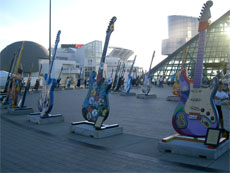🎸 Fender Stratocaster and the Rise of the Electric Guitar in Rock
There’s no symbol more closely tied to rock and roll than the electric guitar. It didn’t just tag along for the ride—it defined the ride. From the early days of fuzzy blues licks to the wailing solos of the arena rock era, the electric guitar has been the heart and howl of the genre.
And at the center of it all? The Fender Stratocaster.
🎷 A Humble Start: Jazz and the First Electric Experiments
The electric guitar didn’t appear out of nowhere in the 1950s—its roots stretch back to the 1930s. Jazz pioneer Charlie Christian was among the first to use an amplified guitar for solos, opening the door to a new level of musical expression.
📺 Watch: Charlie Christian with Benny Goodman – “Solo Flight” (1941)
In the early 1940s, T-Bone Walker, one of the original electric bluesmen, was plugging in and laying the groundwork for what would eventually become rock’s guitar hero persona.
But it wasn’t until Leo Fender stepped in with a factory-friendly, mass-producible design that the electric guitar became a household object—and eventually, a cultural icon.
🛠️ Leo Fender’s Game-Changers

In 1950, Leo Fender introduced the Broadcaster, soon renamed the Telecaster after a trademark scuffle. It was the first mass-produced solid-body electric guitar, and its bright, cutting tone made it an instant favorite—especially for country and rockabilly players.
Then, in 1954, Fender changed the game again with the Stratocaster.
- Three pickups instead of two
- A contoured body for comfort and reach
- And that glorious tremolo bar (a.k.a. the “whammy bar”) for vibrato and pitch bending
It wasn’t just functional—it was futuristic. And it became the weapon of choice for guitar gods like Buddy Holly, Jimi Hendrix, Eric Clapton, and David Gilmour.
Let’s not forget the Fender Precision Bass (P-Bass), introduced in 1951, which gave bassists a chance to plug in and step forward—literally.
🎻 Meanwhile at Gibson: A Les Paul Legend Is Born
Fender wasn’t alone in shaping the future. Over at Gibson, the Mandolin-Guitar Company had been making electric hollow-body instruments since the 1930s. The ES-150, released in 1936, is widely considered the first commercially successful electric guitar.
But the big bang came in 1952, when Gibson teamed up with jazz innovator and tinkerer extraordinaire Les Paul to release a solid-body guitar simply called the Gibson Les Paul.
Les Paul didn’t just slap his name on a guitar—he also revolutionized recording. With his wife Mary Ford, he used multitrack recording (which he basically invented) to layer guitar parts in ways no one had heard before.
His innovations in guitar design and studio tech helped shape modern rock production as we know it.
💃 Chuck Berry: Duck Walk + Riff = Rock Guitar DNA
It’s impossible to talk electric guitars and rock without tipping your cap to Chuck Berry. His duck walk, attitude, and iconic double-stop riffs gave early rock its recognizable sound and style.
Even Michael J. Fox paid tribute in Back to the Future, soloing “Johnny B. Goode” in one of cinema’s greatest musical moments.
🎸 Enter the Guitar Heroes: Hendrix, Clapton, Santana & Beyond
By the late 1960s, the electric guitar had grown far beyond rhythm chords and jump blues.
Players like:
- Jimi Hendrix turned amps into instruments of their own, using feedback, wah pedals, and distortion as expressive tools.
- Eric Clapton made the Les Paul scream with emotion.
- Carlos Santana fused Latin jazz and psychedelic rock into hypnotic guitar lines.
These guitarists weren’t just playing solos—they were redefining what a guitar could do.
🧪 Technology + Style = A New Band Format
Before the electric guitar took center stage, pop bands looked more like miniature jazz orchestras—pianos, stand-up basses, saxophones, and maybe an accordion or two.
But once the electric guitar brought volume and edge to the scene, a new band format emerged:
- Lead Guitar
- Rhythm Guitar
- Electric Bass
- Drums
Simple. Loud. Effective. And iconic.
The four-piece rock band became the blueprint—from The Beatles to The Ramones and beyond. Each instrument carried its own weight. And each band had its own take on how to bend, break, and blow out the limits.
🎸 Guitars on a Pedestal (Literally)

Want proof of the electric guitar’s importance to rock? Just visit the Rock and Roll Hall of Fame in Cleveland, Ohio. Outside the museum, massive sculptures of guitars pay tribute to the instrument that transformed not just music—but youth, culture, fashion, and rebellion itself.
🔚 Final Chord: Long Live the Six-String
From its humble roots in jazz clubs to its screaming presence on stadium stages, the electric guitar has been more than an instrument—it’s been a revolution in wood, wire, and soul.
Whether it’s a Strat, a Tele, a Les Paul, or some garage-sale special with one working pickup and a duct-taped jack, the electric guitar continues to inspire players and fans alike.
So here’s to the guitar solo, the power chord, and that unmistakable feedback squeal.
Rock on. 🎸